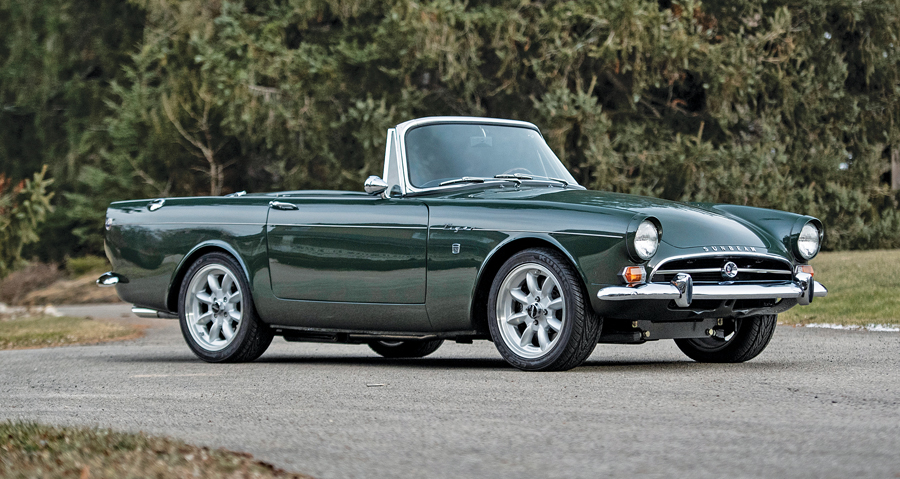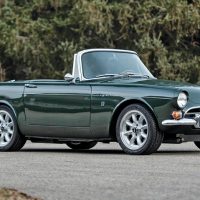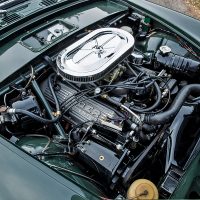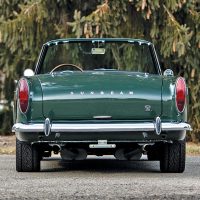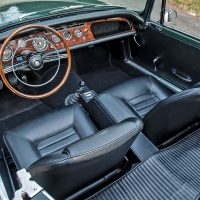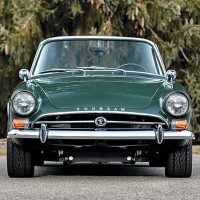SCM Analysis
Detailing
| Vehicle: | 1965 Sunbeam Tiger Mk I |
| Years Produced: | 1964–67 |
| Number Produced: | 6,498 (plus 536 Mk II cars) |
| Original List Price: | $3,425 |
| SCM Valuation: | $70,000 |
| Tune Up Cost: | $300 |
| Distributor Caps: | $35 |
| Chassis Number Location: | On firewall |
| Engine Number Location: | Where the starter bolts onto the block |
| Club Info: | Sunbeam Tiger Owners Club |
| Website: | http://www.sunbeamtiger.co.uk |
| Alternatives: | Austin-Healeys with V8 engines, AC Cobra Mk VI, 1962–65 Shelby Cobra |
| Investment Grade: | B |
This car, Lot 227, sold for $151,200, including buyer’s premium, at RM Sotheby’s Amelia Island Auction in Florida on March 9, 2019.
In 1962, Carroll Shelby introduced a new concept in automotive performance — and turned the sports-car world upside down.
Shelby took a lightweight, rather sexy roadster and transformed it from a proper British sort to an untamed beast of a machine with brutish road manners.
The Shelby Cobra would go on to be one of the most storied automobiles of all time.
One good Cobra deserves another
There was another British car that took that same concept — actually inspired by Shelby’s Cobra — and attempted to accomplish the same end result.
Sunbeam took a small, lightweight British roadster and stuffed a modestly aggressive compact American V8 into it. The end result was the Sunbeam Tiger, aka the “Baby Cobra.”
The Tiger was not nearly as sexy as the refined lines of the AC body used on the Cobra. Yet the Tiger was born from the spiffy — and typically British — upright styling of the Sunbeam Alpine roadster.
As the story goes, Ian Garrad, Rootes’ American West Coast manager, noticed the Cobra’s success. Along with John Panks, the director of Rootes Group America, Garrad set a meeting with Carroll Shelby to discuss the feasibility of fitting a V8 engine into the compact engine bay of the Alpine.
A deal was struck to the tune of about $10,000 to create a prototype using a Ford 260-ci V8, a 4-speed gearbox and other modifications to transform the tame Alpine into a formidable street adversary.
Shelby’s right-hand man, Phil Remington, oversaw the conversion. The modifications required various sheet-metal alterations and rerouting some of the peripheral engine accessories to make it all work.
Lost in the collector-car jungle
For the longest time, Tigers sat on the collector-car sideline.
The Shelby connection was lost in the long shadow of the Cobra and Shelby Mustangs. Collectors just didn’t respect the original Sunbeam Tigers.
Tigers were $25,000–$30,000 cars — on a good day. I’m sure it was partly due to the bland styling. The cars came across as boxy and awkward.
Plus, working on a Tiger was not a walk in the park. The engine bay was tight. Even the simplest of mechanical tasks could become a tedious undertaking.
Like a lot of British cars, the electrical system was not robust, and it wasn’t uncommon for the gauge readings to be a mere suggestion of the actual engine conditions. Because the cars were relatively cheap, most Tigers were hot-rodded, modified and poorly restored.
Along comes a Tiger
Around eight years ago, Tigers suddenly got some traction. I recall being at Mecum’s Kissimmee sale as a British Racing Green Tiger — mostly stock — sat under one of the tents.
I was an SCM auction analyst at the time, and every time I’d walk by the car, a crowd of guys in their late 40s and early 50s were standing around it.
The group’s conversations ranged from the car’s value to stories of owning a Tiger. Every time I walked by the car, there stood a new group of Tiger enthusiasts.
At that moment, I knew the tide had turned from the scrappy feral cat of a car to the feared Tiger that it always deserved to be.
Leaping forward
The market for quality Tigers is creating a new set of valuation benchmarks.
Upon the initial burst of values, some Tigers, even those that didn’t deserve it, started to fetch public-sale numbers in excess of $100,000. Some Tiger II cars — the most valuable of the production’s run — could see $200,000 for a proper example.
Tigers are subdivided into three series: the Mk I, Mk I/A and the Mk II.
The Mk II Tigers cars are the most valuable — due to the smaller production run (around 630 examples) and upgraded Ford 289-ci engines. The Mk I/A cars are between the Mk II and Mk I cars in value.
Some longtime Tiger enthusiasts consider the earliest cars to be the most pure — and thus the most valuable — but that’s a debate for another time.
Our SCM Platinum Auction Database places a median value of $70,000 for the Mk I and Mk I/A cars — and $149,000 for the Mk II. So by that example, a Tiger II could be worth about two times the money of the earlier cars, which is rather simple to remember.
Mauling the value
Our subject Tiger sold all-in for $151,200. As an early Mk I example, the previous statement about early-car values may have come into play.
While the car sold squarely at Tiger II money, it also presented well — and it wasn’t a purely stock example.
It’s common for a Tiger to show up at auction in a modified state.
Our subject car’s engine upgrade, from the original Ford 260-ci to a more formidable Ford 289-ci, does no harm. Other minor modifications, such as the Panasport wheels and subframe connectors, are common additions that do very little to distract from the value. In any case, these modifications are easily reversible.
We have an early Tiger that presented well in an iconic — and very British — color combination.
The engine bay looks to be well sorted and spic-and-span clean.
Obviously, at least two other bidders agreed, as chassis B9471424 sold very well — very well indeed.
Tigers are here to stay and have finally found the respect they have always deserved in the market — as the shirttail cousins to the storied Shelby Cobra. Well sold.♦
(Introductory description courtesy of RM Sotheby’s.)
